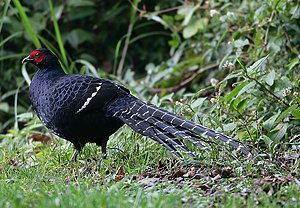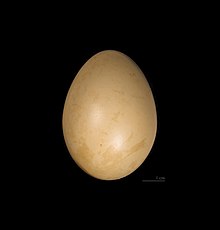Mikado pheasant
| Mikado pheasant | ||||||||||
|---|---|---|---|---|---|---|---|---|---|---|

Rooster of the Mikado pheasant |
||||||||||
| Systematics | ||||||||||
|
||||||||||
| Scientific name | ||||||||||
| Syrmaticus mikado | ||||||||||
| ( Ogilvie-Grant , 1906) |
The Mikado pheasant ( Syrmaticus mikado ) is a Hühnervogel art from the family of pheasant-like . It is endemic to the mountain regions of Taiwan and colonizes undergrowth of bamboo and rhododendron in primary forests at altitudes between 1,600 and 3,300 m.
The story of the discovery is similar to that of the Burmese pheasant . During a trip in the highlands of Taiwan in 1906 , the British naturalist Walter Goodfellow discovered two tail feathers of an unknown species of chicken on the headdress of a local porter. He said he had shot the rare bird on Alishan . Based on the feather find, William Robert Ogilvie-Grant described the species as Calophasis mikado . As a specific epithet he used a title of the Japanese emperor , under whose rule Taiwan was at the time. Soon afterwards, the first bellows came to Europe.
description
The cock of the Mikado pheasant reaches a length of 88 cm, of which 49 to 53 cm are accounted for by the tail. The wing length is between 210 and 230 mm, the weight between 840 and 1200 g. The hen is smaller with a body length of about 53 cm, the tail is 17–22.5 cm shorter. The wing length is between 187 and 215 mm, the weight is around 1000 g. The sexes also differ significantly in the plumage color.
The rooster is predominantly blue-black in color with white bands on the wings and tail. The eye area is red without feathering and shows an erectable lobe in front of the eye and under it. The iris is red-brown, the bill blackish with a yellowish horn-colored lower bill. The chest and shoulder feathers as well as the anterior back are black with a metallic blue sheen like the head and neck, but show dark centers. The lower back as well as the small and medium-sized arm covers are deep black with metallic blue shining hems. Some birds have narrow white seams on the lower back. Broad white seams can be found on the otherwise black, large arm covers, the arm wings show triangular white tips. This creates two parallel bands on the folded wing. The upper one is clearly pronounced, the lower one is narrower, gaps or hardly visible. The hand wings are brown-black. The upper tail-coverts are like the greatly elongated control feathers on a black background with narrow white cross-banded with a clear gap. The lower abdomen and tail-coverts are black, the latter have white tips. The legs and feet are dark gray.
The hen is more inconspicuous and predominantly dark olive-brown in color. The red eye area is less extensive than in the rooster, the iris is lighter brown. The head and neck are olive brown, the sides of the head a little gray and tipped in white, the top of the head and neck a little reddish. The chin and throat are beige, the upper chest is olive brown. The feathers on the underside are lined with olive gray and black and white, the lower abdomen is monochrome gray-olive. The feathers on the upper side are black, scrawled in reddish brown and provided with white, arrow-shaped shaft lines that are sparse on the rump and the upper tail-coverts. The shoulder plumage and the upper wing-coverts are reddish olive-brown, light-colored and fringed and have two subterminal, black spots. The light hems give the impression of narrow wing bands. The wings are banded black on a reddish background, the wings are matt black-brown. The control feathers are reddish brown, spotted black, lined with light and stripes black and beige across. Legs and beak correspond to those of the rooster.
The youth dress is similar to that of the female. The head and neck, however, are strongly mottled with beige. Young cocks can be recognized by their tail feathers after a few weeks.
voice
In general, the mikado pheasant is not very vocal. At the time of reproduction, the roosters emit a high-pitched , long, rising chiri that is repeated at intervals. The vocal feel is a muffled and lined up chup chup , the alarm call a high wok wok wok , which in rare cases can turn into high, loud calls when blown up . The call that the hen makes to young birds is a low chuckle. The feed call at courtship is described as a quiet giek giek .
Distribution and existence
The monotypical mikado pheasant is endemic to the central mountainous region of the island of Taiwan. The species is not uncommon there in suitable habitats, but its occurrence is increasingly limited to nature reserves. In the Yushan National Park , the population is estimated at up to 10,000 animals and occurrences are also known from other protected areas. Outside of these areas, the species is only safe from habitat loss at higher altitudes, and although it also accepts secondary habitats, an increasing fragmentation of the occurrences and presumably a longer-term decline in the population can be expected. The IUCN therefore classifies the species as potentially threatened (“near threatened”). In the past, the Mikado pheasant was decimated in the population through heavy hunting, but this is only a threat today.
Way of life
The Mikado pheasant lives primarily in dense mountain forests of oak , cypress , juniper and pine at altitudes between 1600 and 3300 m and possibly even higher. There should be a dense undergrowth of bamboo and rhododendrons and steep slopes of mountain valleys are preferred. The species also occurs in secondary vegetation.
The species is quite shy and usually behaves very inconspicuously. To search for food, the birds also step out into open areas. It takes place mainly in the morning and evening hours. Roosters are not infrequently found individually, hens usually in the company of a rooster, other hens or young birds. The range of action of the hens seems to be much larger than that of the roosters, which are mostly restricted to a certain area. It is also larger in spring and autumn than in winter.
It is not known whether the species is monogamous or polygamous . Sometimes roosters with two hens were observed. The courtship is only known from captivity. It begins with an erect pace of roosters with swollen red facial lobes and slightly lowered wings. If a hen comes in sight, it is presented conspicuously on its side with fluffed plumage, spread control feathers and wings lowered towards the female. The rooster tries to circle around her, which initially leads to the hen fleeing. The rooster tries to attract the female by pointing out pieces of food and with the feed call. In contrast to other pheasant species, there is still no copula. This is apparently always preceded by a frontal balz, in which the cock straightens up, puts on its plumage, inflates the cervical sacs and erects the facial lobes. In this posture, he hops in long leaps towards the hen.
The breeding season is believed to be between February and May. Nests were found that were built from bamboo stalks at a height of about 1 m on fallen trees. The clutch consists of 5–10 cream-colored eggs, which differ from the eggs of the other Syrmaticus species in their large size and long shape. They measure 55 × 39 mm and are incubated between 26 and 28 days.
literature
- Steve Madge , Phil McGowan : Pheasants, Partridges & Grouse. Helm Identification Guides, London 2002, ISBN 0-7136-3966-0 (English).
- Heinz-Sigurd Raethel : Chicken birds of the world. Neumann-Neudamm, Melsungen 1988, ISBN 3-7888-0440-8 .
- Rüştü Şahin: Contributions to the reproductive behavior of the Mikado pheasant (Syrmaticus mikado) , [Mainz] 1975, DNB 821196227 (dissertation University Mainz 1975, 151 leaves, 30 cm).
Web links
- Syrmaticus mikado in the endangered Red List species the IUCN 2004. Posted by: BirdLife International, 2008. Accessed October 21 of 2010.
- Birdlife Species Factsheet , accessed October 21, 2010
- Videos, photos and sound recordings of Syrmaticus mikado in the Internet Bird Collection
- Photos of Syrmaticus mikado in the Oriental Bird Club image database , accessed on October 21, 2010
Individual evidence
- ^ Charles William Beebe : A monograph of the pheasants , New York Zoological Society, 1918-1922, Vol. 3, p. 197
- ↑ Madge / McGown, p. 319, p. Literature and BirdLife species factsheet, s. Web links
- ↑ Raethel, p. 615, s. literature



